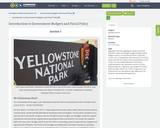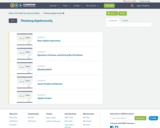
89 Results


The project is designed to help students better understand budgeting. They will also learn about the real-life options and challenges to managing money. Students will learn about gross and net salaries, renting and buying a home, credit scores, savings, loans, and time value of money.
- Subject:
- Mathematics
- Material Type:
- Full Course
- Author:
- Jillian Miller
- Megan Simmons
- Stefanie Holmes
- Jessica Chambers
- Brad Fox
- Heather Doncaster
- Ashley Morgan
- Misty Anderson
- Date Added:
- 07/08/2021

MYOB is designed to show students that the key to financial health is simple: Spend less than you make. Students are expected to set and follow a monthly budget and regularly monitor their checking and savings accounts while avoiding debt. However, students must balance their comfort level as well. In order to win the game, players must achieve and maintain the game goals for each scenario (such as savings, debt, and comfort goals) before time runs out.
MYOB contains ten scenarios, each dealing with different financial challenges and covering a mixture of financial literacy objectives. In each scenario, the player will earn a paycheck every four weeks. After they deposit their paycheck, they are prompted to set a budget for the next four weeks. Then they are free to determine how to spend their TIME, COMFORT, and MONEY, by choosing from any of the options on the screen, from paying bills to going shopping.
Every action the player takes in the game will impact their score in one of these three areas. If the player does not have enough time, comfort, or money to complete an action, the Perform button will be disabled. They will have to either choose a different action or perform an action that will give them enough resources to complete it.
Once the player has used all of the time points allotted for each four-week period, they will see a monthly summary, which provides feedback on their performance during that time. In order to win the game, the player must MEET or EXCEED the minimum SAVINGS REQUIREMENTS, DEBT REPAYMENT GOAL, and COMFORT LEVEL set out at the beginning of the scenario. Throughout the game, the player must strategically use their time, comfort, and money in order to achieve and maintain the scenario goals.
- Subject:
- Business and Communication
- Finance
- Material Type:
- Game
- Author:
- Diana Gedye
- William Thompson
- Date Added:
- 07/08/2024

Federal credit programs involve a unique set of challenges and opportunities. This practical training course for executive and legislative branch decision-makers and staff is aimed at enhancing the understanding of the core financial principles necessary to most effectively design and run those programs. It brings together institutional analysis, risk management and corporate finance disciplines for the purpose of improving the management of federal credit agency resources.
- Subject:
- Business and Communication
- Economics
- Management
- Social Science
- Material Type:
- Full Course
- Provider Set:
- MIT OpenCourseWare
- Author:
- Criscitello, Douglas
- Lucas, Deborah
- Tansey, Charles
- Date Added:
- 06/01/2016

Unit 7 Money Matters: Lessons on Budgeting and Savings
- Subject:
- Economics
- Material Type:
- Unit of Study
- Author:
- Aujalee Moore
- Date Added:
- 05/17/2024
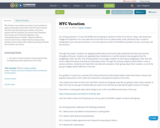
We will have the students use many travel websites to gather information about New York City. Each website will offer data about pricing, activities, and travel options that the students can choose from. Examples that we gave are Travelocity, Expedia, or the Indianapolis Airport website. Using the different sources could cause a debate about pricing among students. Each website offers different pricing and deals that students can choose.
- Subject:
- Education
- Mathematics
- Social Science
- Material Type:
- Data Set
- Date Added:
- 10/05/2016
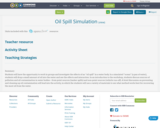
Students will have the opportunity to work in groups and investigate the effects of an “oil spill” in a water body. In a simulated “ocean” (a pan of water), students will drop a small amount of oil into the water and see the effects and interaction. In an introduction to the workshop, students discuss sources of pollution and oil contamination in water bodies – from point sources (tanker spills) and non-point sources (vehicle run-off). A brief discussion on preventing and cleaning up oil contamination will lead into the activity, in which the students will use a variety of materials to see what method works best for recovering the most oil from the water.
- Subject:
- Applied Science
- Biology
- Environmental Science
- Life Science
- Mathematics
- Numbers and Operations
- Material Type:
- Activity/Lab
- Date Added:
- 06/16/2021
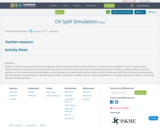
Students will have the opportunity to work in groups and investigate the effects of an “oil spill” in a water body. In a simulated “ocean” (a pan of water), students will drop a small amount of oil into the water and see the effects and interaction. In an introduction to the workshop, students discuss sources of pollution and oil contamination in water bodies – from point sources (tanker spills) and non-point sources (vehicle run-off). A brief discussion on preventing and cleaning up oil contamination will lead into the activity, in which the students will use a variety of materials to see what method works best for recovering the most oil from the water.
- Subject:
- Applied Science
- Biology
- Environmental Science
- Life Science
- Mathematics
- Numbers and Operations
- Material Type:
- Activity/Lab
- Date Added:
- 12/05/2018

Students will have the opportunity to work in groups and investigate the effects of an “oil spill” in a water body. In a simulated “ocean” (a pan of water), students will drop a small amount of oil into the water and see the effects and interaction. In an introduction to the workshop, students discuss sources of pollution and oil contamination in water bodies – from point sources (tanker spills) and non-point sources (vehicle run-off). A brief discussion on preventing and cleaning up oil contamination will lead into the activity, in which the students will use a variety of materials to see what method works best for recovering the most oil from the water. Students will develop a proposal explaining which materials and procedures work best for cleaning up an oil spill. Students will also create a presentation to share their proposal.
- Subject:
- Applied Science
- Biology
- Environmental Science
- Life Science
- Mathematics
- Numbers and Operations
- Material Type:
- Activity/Lab
- Date Added:
- 04/30/2021
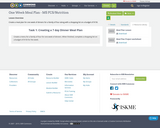
Create a meal plan for one week of dinners for a family of four along with a shopping list on a budget of $150.
- Subject:
- Culinary Arts
- Material Type:
- Lesson Plan
- Author:
- Syd Rundback
- Date Added:
- 11/03/2019
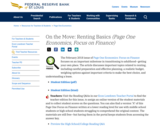
The February 2018 issue of Page One Economics: Focus on Finance focuses on an important milestone in transitioning to adulthood—getting your own place. The article discusses important topics related to renting, including careful preparation and effective planning, a realistic budget, weighing options against important criteria to make the best choice, and understanding a lease.
- Subject:
- Business and Communication
- Economics
- Finance
- Social Science
- Material Type:
- Lesson
- Reading
- Provider:
- Federal Reserve Bank of St. Louis
- Provider Set:
- Page One Economics
- Author:
- Kris Bertelsen
- Date Added:
- 09/11/2019
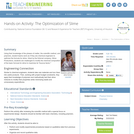
Using their knowledge of the phases of matter, the scientific method, and polymers, student teams work as if they are chemical engineers to optimize the formula for slime. Hired by the fictional company, Slime Productions, students are challenged to modify the chemical composition of the basic formula for slime to maximize its "bounce factor."
- Subject:
- Applied Science
- Chemistry
- Engineering
- Physical Science
- Material Type:
- Activity/Lab
- Provider:
- TeachEngineering
- Provider Set:
- TeachEngineering
- Author:
- Leslie Stiles
- Date Added:
- 09/18/2014
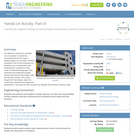
The difference between an architect and an engineer is sometimes confusing because their roles in building design can be similar. Students experience a bit of both professions by following a set of requirements and meeting given constraints as they create a model parking garage. They experience the engineering design process first-hand as they design, build and test their models. They draw a blueprint for their design, select the construction materials and budget their expenditures. They also test their structures for strength and find their maximum loads.
- Subject:
- Applied Science
- Architecture and Design
- Engineering
- Material Type:
- Activity/Lab
- Provider:
- TeachEngineering
- Provider Set:
- TeachEngineering
- Author:
- Abigail Watrous
- Denali Lander
- Janet Yowell
- Katherine Beggs
- Melissa Straten
- Sara Stemler
- Date Added:
- 10/14/2015

The Piggy Bank Primer: Budget and Saving e-book for 7 through 9 year olds uses a story, activities, and puzzles to introduce basic economic concepts saving, savings plan, spending, costs, benefits, goods, services, and opportunity cost.
- Subject:
- Business and Communication
- Economics
- Finance
- Social Science
- Material Type:
- Lesson
- Reading
- Provider:
- Federal Reserve Bank of St. Louis
- Provider Set:
- Economic Lowdown Lessons
- Date Added:
- 10/06/2014
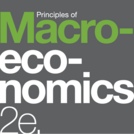
Principles of Macroeconomics 2e covers the scope and sequence of most introductory economics courses. The text includes many current examples, which are handled in a politically equitable way. The outcome is a balanced approach to the theory and application of economics concepts. The second edition has been thoroughly revised to increase clarity, update data and current event impacts, and incorporate the feedback from many reviewers and adopters.Changes made in Principles of Macroeconomics 2e are described in the preface and the transition guide to help instructors transition to the second edition.
- Subject:
- Economics
- Social Science
- Material Type:
- Full Course
- Provider:
- Rice University
- Provider Set:
- OpenStax College
- Date Added:
- 06/29/2017
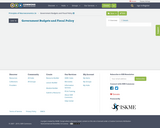
- Subject:
- Economics
- Social Science
- Material Type:
- Unit of Study
- Provider:
- Rice University
- Provider Set:
- OpenStax College
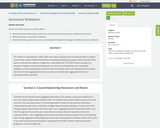
By the end of this section, you will be able to:
Describe how the federal government can use discretionary fiscal policy to stabilize the economy
Identify examples of automatic stabilizers
Understand how a government can use standardized employment budget to identify automatic stabilizers
- Subject:
- Applied Science
- Material Type:
- Module
- Date Added:
- 09/20/2018

This is a first course in project management, one in which students will learn the knowledge, skills, and abilities necessary to be an effective project manager. They will learn how to plan, execute, and monitor a project. The course will cover the latest theories and concepts on scoping, stakeholder management, team leadership, budgeting and contracting, scheduling, quality control and assurance, and risk management. Students will have the option to apply their learning to a real-world project.
- Subject:
- Business and Communication
- Material Type:
- Full Course
- Date Added:
- 08/07/2023

